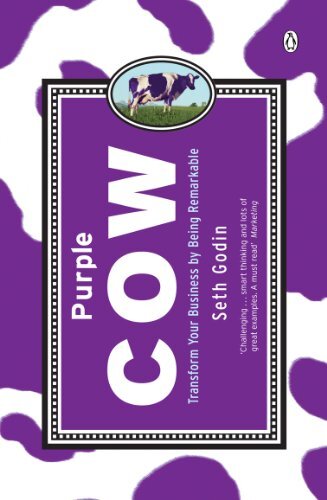
This book offers a small amount of solid, valuable advice:
The purple cow
Imagine you’re driving down the road and see a normal white/black cow. Do you stop and pay it any attention? Probably not. But what if you saw a purple cow? That would almost certainly catch your attention. At least, for a while. If all the cows for the next several hours of your drive were purple, you’d stop noticing them too.
The world of marketing works the same way. If you want people to notice your product, it must be a purple cow: that is, it must be something remarkable. It must stand out enough that people can’t help but stop and comment on it. And this is something that will change over time, as what was remarkable yesterday may not be remarkable tomorrow.
It must be built into the product
Building a purple cow is not about doing outrageous, attention-seeking things. It’s not about crazy ads or stunts or expensive marketing campaigns or hype. Those sorts of approaches may get you a small amount of attention initially, but it’s not sustainable if the product itself doesn’t keep that attention. Therefore, the purple cow must be part of the product itself.
The product itself must be substantially different in some way than any of the competitors. And that means that the job of marketing is not in figuring out how to advertise some existing product, but to get involved in the design of the product itself to make sure that what you’re trying to sell is truly remarkable. This is the same message as in the book Differentiate or Die: to succeed, you must stand out.
Safe is risky
Since being different is the only way to succeed, that implies that the “safe” choice is usually the one that’s most risky, as it’s the least likely to succeed. You can’t afford to be boring. You can’t even afford to be “very good.” You must aim to “be the most.” That is, be the smallest; or be the biggest; or the fastest; or the nicest. Stand out and get people talking!
A great recent example of this was the Tesla Truck. They could’ve gone for a “safe” option and built a totally standard look truck that happened to be electric. But if they had done that, you probably would’ve never heard of it. Instead, they came up with a crazy design out of an 80’s sci-fi movie, and it made headlines across the world.
Seek out markets with otaku
Otaku is a Japanese word that refers to something that is more than hobby but less than obsession. For example: the hot sauce market has otaku, as some people go to great lengths to find the spiciest, tastiest, most extreme hot sauce they can. If your product stands out in a market with otaku, people won’t be able to stop talking about it. Note that some markets seem to inherently have more otaku than others: e.g., hot sauce has it, but mustard does not.
Other thoughts on the book
Beyond that, this book doesn’t offer much. There are no instructions on how to build a purple cow, or find otaku, or anything else; there is a large focus on TV ads and consumer products, which won’t apply to many companies; there is a discussion of how big companies always do “safe” things and can never be remarkable, using Disney and Marvel as examples… and yet, 17 years later, Disney owns Marvel and in 2019, it was responsible for 80% of the top box office hits!
So, overall, it’s a mixed bag. A few critical points everyone in marketing should know—the term “purple cow” pops up frequently in my thinking nowadays—surrounded by a bunch of fluff.
